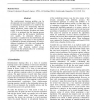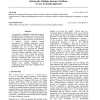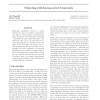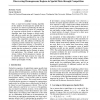114
click to vote
ICML
2000
IEEE
15 years 5 months ago
2000
IEEE
We propose a new rule induction algorithm for solving classification problems via probability estimation. The main advantage of decision rules is their simplicity and good interp...
100
click to vote
ICML
2000
IEEE
15 years 5 months ago
2000
IEEE
We present feature transformations useful for exploratory data analysis or for pattern recognition. Transformations are learned from example data sets by maximizing the mutual inf...
129
click to vote
ICML
2000
IEEE
15 years 5 months ago
2000
IEEE
Cognitive modeling with neural networks unrealistically ignores the role of knowledge in learning by starting from random weights. It is likely that effective use of knowledge by ...
116
click to vote
ICML
2000
IEEE
15 years 5 months ago
2000
IEEE
The reinforcement learning problem can be decomposed into two parallel types of inference: (i) estimating the parameters of a model for the underlying process; (ii) determining be...
143
click to vote
ICML
2000
IEEE
15 years 5 months ago
2000
IEEE
In this paper, we describe our research in computer-aided image analysis. We have incorporated machine learning methodologies with traditional image processing to perform unsuperv...
103
click to vote
ICML
2000
IEEE
15 years 5 months ago
2000
IEEE
This paper considers approaches which rerank the output of an existing probabilistic parser. The base parser produces a set of candidate parses for each input sentence, with assoc...
123
click to vote
ICML
2000
IEEE
16 years 1 months ago
2000
IEEE
As opposed to traditional supervised learning, multiple-instance learning concerns the problem of classifying a bag of instances, given bags that are labeled by a teacher as being...
ICML
2000
IEEE
16 years 1 months ago
2000
IEEE
107
click to vote
ICML
2000
IEEE
16 years 1 months ago
2000
IEEE
Clustering algorithms conduct a search through the space of possible organizations of a data set. In this paper, we propose two types of instance-level clustering constraints ? mu...
132
click to vote
ICML
2000
IEEE
16 years 1 months ago
2000
IEEE
If all features causing heterogeneity were observed, a mixture of experts approach (Jacobs et al., 1991) is likely to be superior to using a single model. When unobserved or very n...




